Low back pain is a significant musculoskeletal issue affecting nearly a quarter of the population. It can cause those affected to lose up to 10% of their work time each year. Beyond persistent pain, it also reduces mobility and distress, impacting various aspects of a person’s life, including sleep health.
Studies estimate that nearly 60% of people with low back pain experience disrupted sleep and low sleep quality. These sleep disturbances can cause various consequences, such as chronic fatigue, stress and irritability, low productivity, and more intense pain.
Fortunately, it is not necessary to live with lower back pain daily. At NextPain Care, we offer a range of treatment options that can help alleviate low back pain, improve sleep quality, and build the foundation for long-term musculoskeletal health. Learn more below.
Different Types Of Lower Back Pain
According to 2023 statistics, over 23% of adults suffer from back pain, but other studies suggest that the lifetime prevalence of this condition might be as high as 84% in the adult population.
While this musculoskeletal condition is widespread, it remains challenging to diagnose and treat for several reasons. Firstly, back pain can be either “primary” – if it is the condition – or “secondary” – if it is a symptom of another underlying condition like pancreatitis, endometriosis, or renal colic.
Additionally, the causes of low back pain are often difficult to pinpoint. Currently, up to 85% of cases of low back pain are classified as “non-specific,” meaning there is no inflammation, structural problem, or disease causing the pain.
Moreover, the symptoms of low back pain may vary in nature and intensity from one person to another. Some patients experience shooting pain that runs from the lower back through their buttocks and legs, while others experience life-limiting dull aches for months at a time.
Depending on your symptoms, your healthcare provider may classify your back pain as axial or radicular to simplify the process of obtaining a diagnosis and finding the right line of treatment. Let’s look at these conditions below.
Axial Low Back Pain
Axial back pain is pain concentrated in a single area, usually the lumbar (lower) spine. It is the most common type of low back pain and is often non-specific, meaning no injury or disease is at its root cause.
This type of low back pain is often structural or mechanical and tends to be associated with degenerating the spine’s components without usually involving inflammation. Although it can resolve independently within a few days to weeks, this musculoskeletal condition can significantly impact a person’s life.
Axial back pain can either be acute or chronic:
- Acute axial back pain: Acute pain can be intense but doesn’t last longer than a few days. It does not cause long-term disability or loss of function and tends to resolve on its own with at-home remedies.
- Chronic axial back pain: Low back pain that lasts three months or longer may not be intense at first, but it grows in severity over time and can lead to disability. Chronic back pain may arise due to lifestyle and occupational risk factors, injury, or disease, and it does not improve until its underlying cause is addressed.
Radicular Back Pain
Radicular low back pain originates in the lower back, travels along the spine, and radiates to the hip, buttocks, and legs. This type of back pain is often associated with injury to the nerves that radiate from the spinal nerve root.
When one or more of these nerves are compressed or irritated, the normal transmission of sensory and motor signals to and from the brain is disrupted. This results in other symptoms like burning sensations, numbness, muscle weakness, and tingling.
In some cases, this type of pain resolves itself within six weeks, but it can also be recurring or chronic. Two of the most common causes of radicular back pain include:
- Intervertebral disc injury (IDD): Intervertebral disc degeneration occurs when the cartilaginous cushions between the vertebrae are damaged. Torn, bulging, or herniated discs can compress the nerves running alongside the vertebrae in the spinal cord, causing shooting pain, numbness, and “pins-and-needles” sensations.
Sciatica: Sciatica is one of the most common causes of back pain, affecting up to 40% of people at least once in their lifetime. It occurs when a herniated disc, overgrowth of bone, or abnormal tissue (e.g., a tumor) compresses the sciatic nerve, which runs from the lower back through the hip and down the leg.

Lower Back Pain And Sleep Connection
Low back pain can take many forms and disrupt daily life. Chronic and acute back pain can prevent you from getting the quality sleep you need to be energized and productive during the day.
A 2015 study shows low back pain is strongly associated with short sleep duration and poor sleep quality. The reasons for this include:
- Low back pain makes it difficult to find a comfortable position, causing frequent movement and wakefulness during the night.
- At night, fewer external stimuli and distractions cause patients to focus more on their pain and distress before going to sleep, making it harder to fall asleep and intensifying the pain.
- Certain medications that address low back pain may interfere with the normal sleep cycle, causing sleep disturbances.
- Chronic low back pain is often associated with psychological complications such as depression, anxiety, and stress. These comorbidities are linked to sleep disturbances and disorders like insomnia.
It is also important to consider that certain risk factors for low back pain, such as excessive alcohol consumption and a sedentary lifestyle, can worsen sleep quality.
How Poor Sleep Quality Can Worsen Lower Back Pain
Experiencing both low back pain and poor sleep quality can create a vicious cycle. A 2014 study showed that poor sleep quality caused by back pain is often followed by a day of higher pain intensity, making it even more difficult to get good-quality sleep the next night.
This two-way relationship between poor sleep quality and back pain is mutually reinforcing. While this may be a temporary problem for those experiencing occasional aches, patients with chronic back pain can see their lives profoundly disrupted by these dynamics.
Some ways in which poor sleep affects pain include the following:
- A 2013 study shows that sleep disturbances interfere with key processes and chemicals necessary to modulate pain sensations. The study also found that sleep impairments caused by low back pain often predict new injuries and more intense chronic pain.
- Sleep discrepancies interfere with the normal nighttime release of growth hormone, a key chemical responsible for pain modulation and healing of damaged tissues. Changes in growth hormone production can lead to longer-lasting and more intense low back pain.
- A 2020 study found that lower sleep quality is directly associated with lower pain tolerance. Sleep deprivation may increase the activity of the central nervous system, making painful sensations feel more intense.
- Research conducted in 2021 shows that sleep deprivation can alter the functioning of the immune system, leading to high levels of sustained inflammation. Pro-inflammatory processes can worsen the painful sensations, swelling, and redness often accompanying lower back pain disorders.
Lastly, it is important to highlight the relationship between a lack of sleep and the prevalence of mental health disorders. Anxiety, depression, and high levels of stress can impact your physical health and worsen your chronic pain.
While targeting the root cause of your back pain is essential to finding a permanent remedy, there is much you can do to improve your sleep quality and ease your back pain. Start by finding the best sleeping position for your lower back.
Four Best Sleeping Positions For Lower Back Pain
Given that we spend seven to nine hours lying in bed, how we position ourselves during sleep plays a major role in determining how forces are distributed across the spine and how the vertebrae align when lying down. Proper spine alignment can ease pressure on the lower back, alleviate pain, and improve overall spine health.
Generally, any sleep position that involves twisting or contorting the spine should be avoided, as it puts pressure on certain vertebrae. Finding a comfortable position that keeps the spine aligned and the weight equally distributed is important.
While investing in a high-quality mattress and pillows is an important step to getting a better night’s sleep, positioning yourself correctly before falling asleep can also help. Let’s explore the benefits of these positions below.
1. Sleep On Your Back With Pillows
One of the healthiest ways to sleep is on your back, using a pillow under your lumbar spine to promote natural spine alignment. This position helps your head, neck, and hips remain neutral throughout the night, relieving pressure points on the lumbar spine.
For additional support, place a pillow under your neck and a small, rolled towel under the lower curve of your spine. This position is recommended if you are naturally a back sleeper.
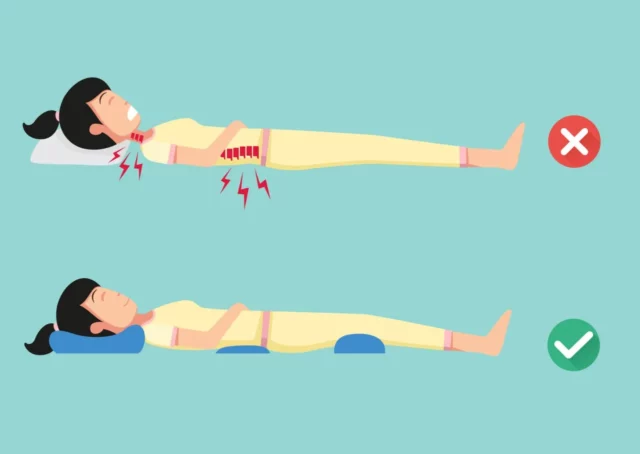
2. Sleep On Your Side
Sleeping on your side with your knees partially bent is another excellent option to relieve back pain. This position keeps the spine neutral and naturally aligned while alleviating pressure on the cartilage discs between the vertebrae. As these discs regain hydration and thickness during the night, they can reduce pressure on the spinal column components, including bones, joints, and nerves.
To maximize the benefits of this position, follow these steps:
- Draw your legs up towards your chest slightly to help maintain balance and prevent rolling onto your back, which can cause the spine to curve backward.
- Place a pillow between your legs to keep the spine neutral and distribute body weight evenly. You can also use a full-body or maternity pillow.
- Close the gap between your waist and the mattress with a small rolled-up towel to prevent your middle spine from sagging towards the mattress.
- Change the side you sleep on regularly to prevent imbalances and abnormal curvatures.
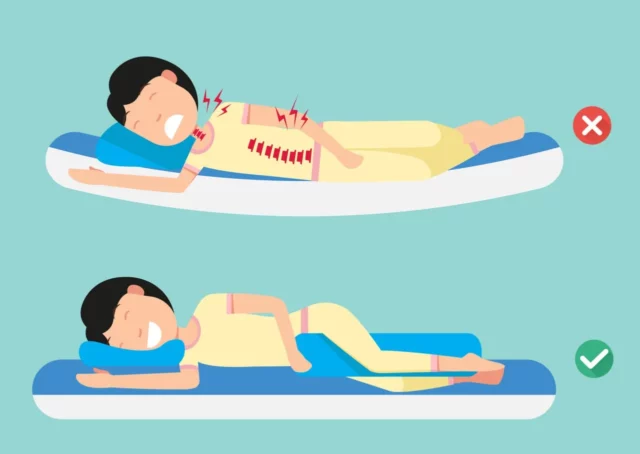
If your lower back pain is caused by herniated discs, sleeping in a fetal position may also be beneficial. Drawing your legs closer to your torso can stretch the spine, allowing the discs to plump up and reduce pressure on the spinal cord.
3. Lay On Your Back In A Reclined Position
If you prefer to sleep on your back, you can do so in a reclined position. Investing in an adjustable bed or arranging your pillows to create a gentle slope can help you maintain a comfortable position throughout the night.
Reclining reduces pressure on the lower back and creates an angle between the higher and lower parts of the body at the hips. This angle can reduce the pressure when lying flat on your back, particularly if you suffer from spondylolisthesis. In this condition, a vertebra slips over an adjacent one in the lower spine, causing pain and spine instability.
4. Lay Flat On Your Back With A Pillow Underneath Your Knees
If you change positions often or prefer to sleep on your back without pillows under your spine, consider lying flat on your back and placing a pillow (or rolled-up towel) underneath your knees instead.
This position feels natural to most sleepers and ensures the correct spine alignment. The pillow under the knees helps maintain a neutral curvature in the lower back, preventing it from sagging into the mattress.
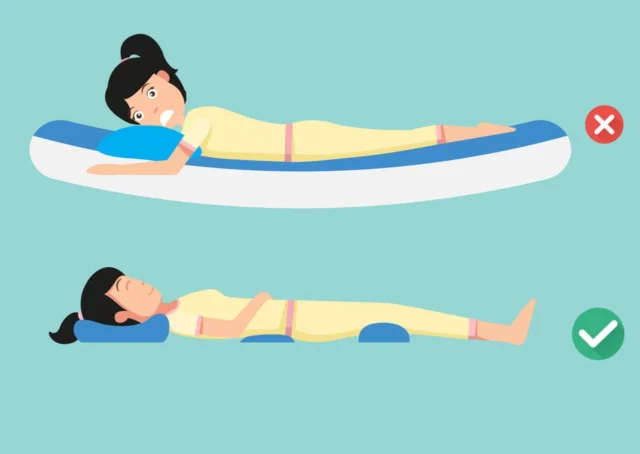
Sleeping Positions To Avoid
Some sleeping positions can counterbalance your spine health and even intensify your lower back pain. This is especially true for back and stomach sleepers who don’t use props such as pillows, rolled-up towels, and reclining mattresses.
Below, we’ll examine some sleeping positions that can aggravate lower back pain and its complications by adding pressure to the spine.
Sleeping On Your Stomach
Sleeping on your stomach can cause the spine to bend backward and pressure certain areas, such as the neck and lumbar spine. Additionally, since you’ll need to twist your head to breathe when lying prone, you’ll be contorting the spine and affecting its natural alignment.
If you tend to sleep on your stomach and struggle to break the habit, there are ways to reduce the strain on your lower back:
- Use a pillow under your head only if it doesn’t add pressure to the spine.
- If using a pillow, opt for a thin one that prevents an abnormal curvature of the spine.
- Place a supportive pillow under your hips, pelvis, or abdomen to align the spine.
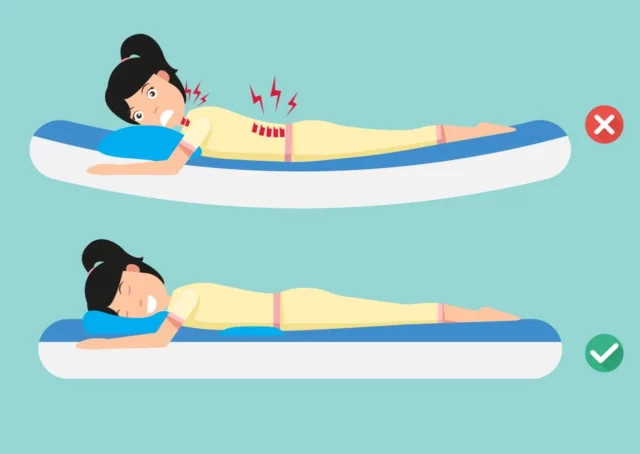
If you suffer from degenerative disc disease, sleeping on your stomach with the necessary props can be beneficial. This position removes most external pressures from the intervertebral discs, allowing them to swell and re-expand, thus moving back into position away from the nerves in the spinal cord.
Sleeping On Your Back
As seen above, sleeping on your back without the necessary tools can cause multiple misalignments in the spine. Correct your sleeping position with pillows under your knees, legs, and lower back to prevent this habit from exacerbating your back pain. This simple solution will help you support the spine’s natural curve and maintain a neutral position while you sleep.
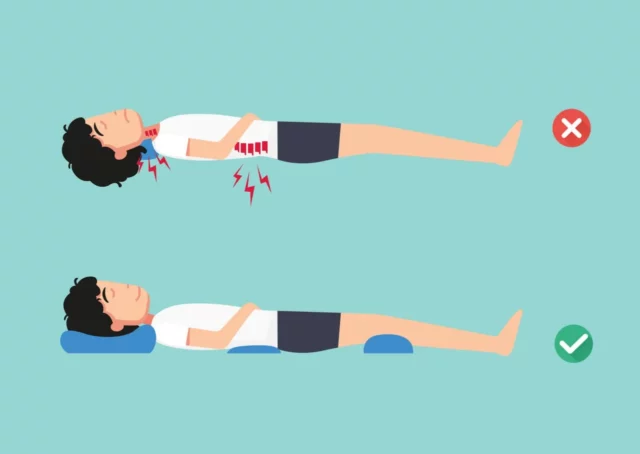
Sleep Solutions For Those Dealing With Lower Back Pain
Sleeping in a position that eases pressure on your lower back and maintains proper spine alignment is an excellent strategy to improve sleep quality. However, this isn’t the only factor influencing your overall spine and sleep health.
Below are some easy-to-adopt sleep solutions that can ease your back pain.
Tip: According to a study published by The Lancet, the key risk factors for non-specific low back pain include having a physically demanding job, smoking, being obese, battling a mental health disorder, and leading a sedentary lifestyle. Addressing these lifestyle factors is key to improving sleep quality and spinal health.
Invest In A Quality Mattress
Your choice of mattress plays a significant role in your sleep quality and the intensity of your lower back pain. With the wrong mattress, you may be unable to adjust your sleeping position to promote proper spine alignment.
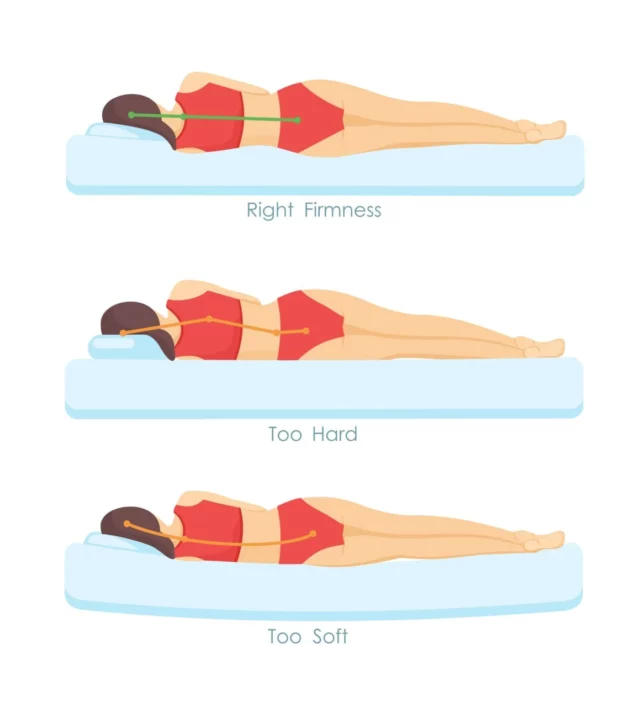
To ease back pain and promote health, consider upgrading to a medium-firm mattress that offers lumbar support and is designed with hypoallergenic materials. The level of firmness should be adjusted to your weight and preferred sleeping position.
For pillows, opt for ergonomically designed and supportive models. Ensure the thickness does not cause your spine to sag or bend abnormally.
Exercise Regularly
Studies have confirmed a two-way connection between physical activity and sleep quality. Sleeping seven to nine hours each night can help you replenish energy, boost physical performance, support mental health, and stay motivated to exercise daily.
Leading an active lifestyle and partaking in regular physical activity can offer many benefits for your sleep quality and spine health:
- Adequate conditioning can help you strengthen muscles and boost flexibility, reducing the risk of spine injuries, pain, and degenerative disorders.
- Exercise increases the body’s temperature, signaling the brain that it’s time to be awake. After a workout, the body temperature drops, inducing sleepiness.
- Physical activity triggers the release of endorphins, the body’s natural painkillers. These chemicals induce a generalized sense of well-being, improving sleep quality, reducing low back pain, and easing symptoms of mental health disorders like anxiety.
- Exercise can help combat obesity and overweight, which are known risk factors for low back pain.
Avoid Alcohol And Caffeine Before Sleeping
Both alcohol and caffeine can significantly disrupt your sleep.
Caffeine is a stimulant that blocks sleep-promoting receptors in the brain, causing heightened feelings of awakeness and alertness. Even when taken six hours before bed, caffeine can delay falling asleep by one hour.
On the other hand, alcohol is a relaxant and can initially help you doze off. However, after a few hours of sleep, alcohol can cause you to wake up and make it difficult to go back to sleep. This reduces your time in the REM (rapid eye movement) phase, leading to disturbed sleep that fails to bring restfulness. Even a low amount of alcohol (one or two drinks) can reduce your sleep quality by over 9%.
It is also important to note that alcohol and nicotine increase inflammation, which can intensify your lower back pain.
Follow A Bedtime Routine
While a bedtime routine alone may not alleviate your lower back pain, it can help you fall asleep faster and remain asleep longer. As mentioned earlier, a good night’s sleep can help reduce painful sensations and make your condition more manageable.
When designing a bedtime routine that suits your needs, consider the following aspects:
- Have a consistent sleep schedule: going to sleep and waking up at the same time every day can help reset your body’s circadian rhythm, as confirmed by a 2022 study, which influences your sleep quality and duration.
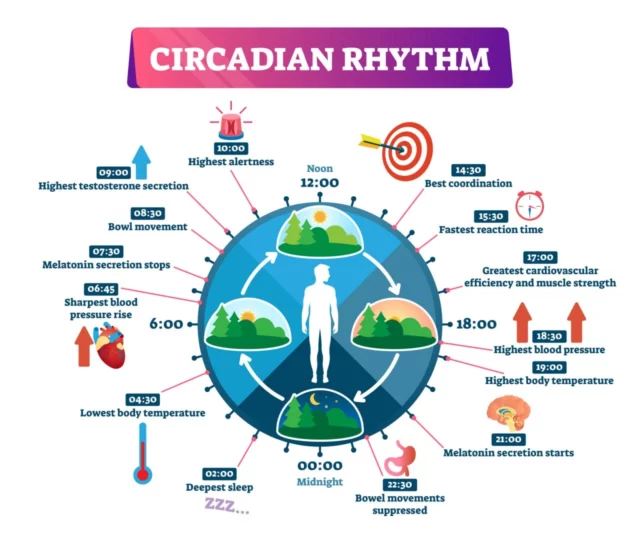
- Sleep in a dark room and seek exposure to natural light as soon as you wake up to help regulate the natural production of sleep-inducing hormones, such as melatonin. Avoid blue light-emitting devices before bed, as these can disrupt the release of melatonin at nighttime.
- Try relaxation techniques like massages, warm baths, light yoga, and breathing exercises to activate the parasympathetic nervous system, which is responsible for calming and relaxing the body.
Consider Using A Sleep Aid
Some sleep medications, such as sedating antihistamines Benadryl and Unisom, can help you fall asleep faster, even when experiencing pain. Alternatively, you may try natural alternatives like melatonin supplements and teas infused with relaxing plants such as valerian.
However, it is important to note that sleep aids may not work equally well for everyone and are not free of side effects. Most sleep medications and supplements can cause drowsiness, daytime sleepiness, urinary incontinence, headache, nausea, and constipation.
Due to the risks associated with this treatment, you should only consider taking sleep aids during low back pain flare-ups and under the supervision of a specialist.
Position Yourself Properly
Finding the right sleeping position for your needs remains one of the most important strategies for improving sleep quality and easing lower back pain. Test the positions mentioned above to find the best one for your needs, and don’t be afraid to experiment with pillows, rolled-up towels, and other support tools.
When To Consult A Physician About Your Back Pain
Although low back pain can be life-altering, it often resolves on its own with the help of at-home remedies. However, in some cases, low back pain can be a sign of an underlying disease, a degenerative spine condition, or severe mechanical problems. Because of this, it is crucial to understand when you should see a doctor.
Generally, you should contact your healthcare provider if your lower back pain isn’t improving. It is also recommended that you see a doctor if poor sleep quality interferes with your ability to live your life normally.
Other signs and symptoms associated with back pain that should not be overlooked include:
- Low back pain that starts with an injury
- Worsening or ongoing pain that lasts longer than a few days
- Painful sensations that radiate to other areas of the body
- Feelings of numbness or loss of sensation
- Debilitating pain that interferes with your life
- Severe symptoms like swelling, fever, unexplained weight loss, and urinary problems
You should also seek an accurate diagnosis if you have a personal history of cancer.
Find Relief From Lower Back Pain With NextPain Care
Lower back pain can greatly affect your daily life, starting with your ability to get a good night’s sleep. At NextPain Care, we understand how challenging this can be and are here to help. Medications and sleep aids are not your only options for relief.
Our three-level approach is designed to manage your back pain and improve your sleep quality effectively. We start with non-invasive treatments such as physical therapy and other minimally invasive options, focusing on restoring your musculoskeletal health.
If needed, we can integrate more advanced therapies and medications, always under the careful supervision of our physicians.
At NextPain Care, we are dedicated to providing personalized, compassionate care that addresses your unique needs. We’re here to support you every step to better health and well-being.
Losing sleep because of persistent pain in your lower back?

